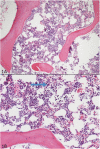Acquired Amegakaryocytic Thrombocytopenia Misdiagnosed as Immune Thrombocytopenia: A Case Report
- PMID: 33482950
- PMCID: PMC7849287
- DOI: 10.7812/TPP/19.203
Acquired Amegakaryocytic Thrombocytopenia Misdiagnosed as Immune Thrombocytopenia: A Case Report
Abstract
Introduction: Acquired amegakaryocytic thrombocytopenia (AATP) is a rare bleeding disorder that causes severe thrombocytopenia with preserved hematopoiesis of other cell lineages. Many cases are misdiagnosed and treated as immune thrombocytopenia.
Case presentation: We report a case of AATP, in a 50-year-old man, that was treated as immune thrombocytopenia for years with no clinical response. The disorder later was diagnosed as AATP after bone marrow biopsy and was successfully treated with cyclosporine.
Discussion: The exact mechanism of AATP remains unclear; it is suspected to be an immune-mediated process. Patients with AATP present with severe bleeding and thrombocytopenia, which is usually unresponsive to high-dose corticosteroids. There are no standard treatment guidelines for AATP. Cyclosporine and antithymocyte globulin are found to be effective in some cases. The prompt diagnosis of AATP is vital because it carries high mortality because of excessive bleeding, and it can progress into aplastic anemia or myelodysplastic syndrome.
Copyright © 2020 The Permanente Press. All rights reserved.
Figures



Similar articles
-
Acquired Amegakaryocytic Thrombocytopenia Misdiagnosed as Immune Thrombocytopenia in a Patient with Seronegative Arthritis: A Case Report.J Assoc Physicians India. 2023 Nov;71(11):100-102. doi: 10.59556/japi.71.0386. J Assoc Physicians India. 2023. PMID: 38720507
-
Acquired amegakaryocytic thrombocytopenia after durvalumab administration.J Clin Exp Hematop. 2021 Mar 18;61(1):53-57. doi: 10.3960/jslrt.20047. Epub 2021 Jan 8. J Clin Exp Hematop. 2021. PMID: 33431742 Free PMC article.
-
[Successful rituximab treatment for acquired amegakaryocytic thrombocytopenic purpura complicated with Coombs-negative autoimmune hemolytic anemia].Rinsho Ketsueki. 2013 Jun;54(6):568-73. Rinsho Ketsueki. 2013. PMID: 23823096 Review. Japanese.
-
Acquired Amegakaryocytic Thrombocytopenic Purpura Progressing into Aplastic Anemia.Prague Med Rep. 2017;118(4):147-155. doi: 10.14712/23362936.2017.16. Prague Med Rep. 2017. PMID: 29324222
-
Acquired Amegakaryocytic Thrombocytopenic Purpura: A Review of Therapeutic Options.Hematol Oncol Stem Cell Ther. 2023 Apr 4;16(3):291-302. doi: 10.56875/2589-0646.1063. Hematol Oncol Stem Cell Ther. 2023. PMID: 37023223 Review.
Cited by
-
Acquired Amegakaryocytic Thrombocytopenia Progressing to Aplastic Anaemia.Eur J Case Rep Intern Med. 2022 Sep 5;9(9):003479. doi: 10.12890/2022_003479. eCollection 2022. Eur J Case Rep Intern Med. 2022. PMID: 36299833 Free PMC article.
-
Transient Acquired Amegakaryocytic Thrombocytopenia in the Setting of Severe Sepsis: A Case Report.Cureus. 2024 Jul 8;16(7):e64072. doi: 10.7759/cureus.64072. eCollection 2024 Jul. Cureus. 2024. PMID: 38979026 Free PMC article.
-
Acquired Amegakaryocytic Thrombocytopenia Associated With Autoimmune Hemolytic Anemia.Cureus. 2022 Jul 26;14(7):e27315. doi: 10.7759/cureus.27315. eCollection 2022 Jul. Cureus. 2022. PMID: 36042987 Free PMC article.
-
Novel THPO variant in hereditary thrombocytopenia: A potential candidate variant for predisposition to myeloid neoplasm.PLoS One. 2022 Dec 19;17(12):e0271624. doi: 10.1371/journal.pone.0271624. eCollection 2022. PLoS One. 2022. PMID: 36534659 Free PMC article.
-
Successful avatrombopag combined with cyclosporine treatment for carboplatin/pegylated liposomal doxorubicin/bevacizumab-induced acquired amegakaryocytic thrombocytopenia in a patient with recurrent ovarian cancer: case report.Front Oncol. 2024 Feb 9;14:1253230. doi: 10.3389/fonc.2024.1253230. eCollection 2024. Front Oncol. 2024. PMID: 38406810 Free PMC article.
References
Publication types
MeSH terms
Supplementary concepts
LinkOut - more resources
Full Text Sources

